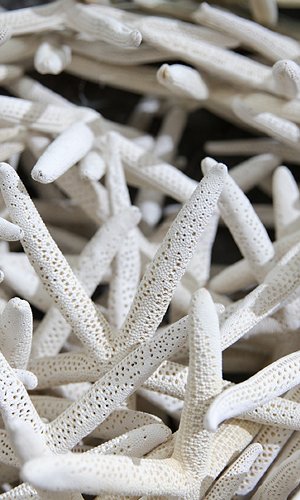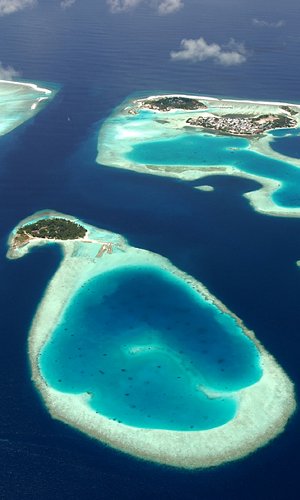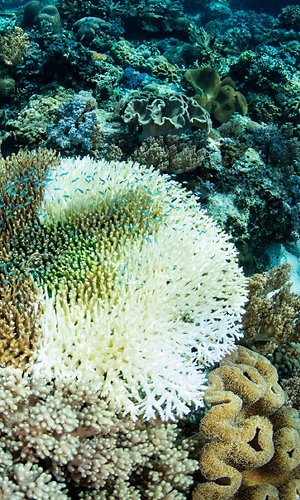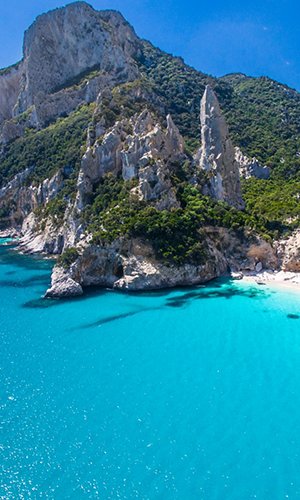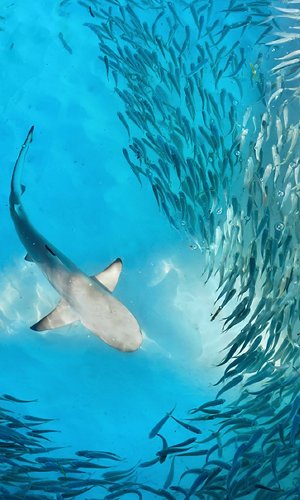The seas of the tropical regions, where the water temperature is around 25 degrees, are an ideal environment for the madrepora: this name is used to indicate different varieties of animals, formed by hundreds of small polyps, belonging to the coelenterate type, that live in colonies with calcareous structures that branch into many different shapes. Many coral species live together and form a shelter for a large number of sea inhabitants such as the clownfish, surgeonfish, gigantic molluscs.... crustaceans, triggerfish and sea urchins are a few of the creatures that populate the coral barrier.
Voice search

The barrier reef or simply “reef” is one of the ecosystems with the highest number of species in the world. It is a wide and massive calcareous formation of animal origins with myriad colours and shapes. Responsible for the building of this biome are madreporic anthozoa, also known as the 'builder corals".
Corals or madrepores are composed of small polyps of differing sizes (from few mms to a few cms) surrounded by a calcareous calyx called “corallite” which looks different according to the species. Each polyp hosts unicellular algae called “zooxanthellae”, which give them a brown-greenish colour. This particular combination is called ""mutualism", i.e. both species benefit from living together. The algae, through the photosynthesis of the chlorophyll, supply the polyp with energy in the form of sugars, produce oxygen and remove carbon dioxide (which could form carbonic acid and damage the calcareous skeleton of the polyps). In return, the polyp offers protection to the microscopic and numberless algae. Every square centimetre of the madrepore can contain up to one million zooxanthella algae.
The reefs are composed of calcium carbonate (CaCO3) used by the coral polyps to build their own Coral formations develop mostly between the water surface and a depth of thirty metres. They need three environmental conditions to grow:
- a mean water temperature above 20°C in winter;
- constant salinity;
- plenty of light.
Only in these specific conditions can the corals grow and reproduce. Some species (such as the brain coral) grow between 5 and 25 mms a year, others (such as the antler coral) grow much quicker, up to 10-20 cm a year. The reef is an ever-growing ecosystem since new polyps grow on the old ones that die and so the surface area is always composed of live corals.
Related topic
The coral reef in the world
Reefs are only in the Tropical seas and cover a total of approximately 600,000 km2. The areas with the largest reefs are three:
- the Caribbean;
- the western islands of the Indian Ocean;
- the Asian-Pacific area.
The latter area is the richest in corals species, with peaks in the Indonesian islands, the Philippines and Northern Australia, while the Indian Ocean and the Pacific have fewer species. There is no relation between the number of coral species and the size of the reef; most of the massive reefs and atolls of Polynesia consist of less than fifty species, versus over five hundred in the Borneo or the Philippines.
Coral inhabitants
Extraordinary algae and plants
The coral structure offers a surprising variety of habitats for plants and animals. In addition to the algae that live within corals, the vegetal world also includes a large number of red algae, such as the encrusting alga Porolithon of the Asian Pacific area or some green algae, such as the Caulerpa. It has been calculated that 1-5 kgs of algae per square metre are produced every year in the reef. Lagoons and sheltered sandy areas are also home to such water plants as the Thalassodendron, which forms underwater prairies like those of the Mediterranean Posidonia, a plant loved by sea turtles as well.
Colourful inhabitants of the reef
Very many are the herbivore animals feeding on the plants that grow in the reef: sea urchins, crustaceans, molluscs and a number of species of fish. Parrot fishes (so called for their strong beak-shaped mouth) and surgeon fishes (so called due to the presence of a lamella as sharp as a scalpel on their tail) are the main herbivores. The mouth of the parrot fish is specialised in taking seaweed off the coral surface, leaving unmistakable marks of their passage. In this way, they also take off the surface layer of the calcareous skeleton, which, undigested, is then expelled in the form of coral sand. Other big coral eaters are the prickly starfish Acanthaster; if many individuals of this species concentrate in one area, they can seriously damage the reef. The sea worm Hermodice caruncolata that lives in the Caribbean can devour one square centimetre of coral in an hour; the lionfish too (such as flag lionfish) mainly feed on coral polyps and other small animals they find amidst the cracks and hideouts that the barrier offers. These fishes have small protruding mouths that, like tweezers, can reach into the narrowest cracks. Many other fishes have mouths like these, such as the angelfish, the beautiful Zanclus canescens (similar to the lionfish), some file fishes and many others, all predators of small invertebrates. The crossbow fish, the globefish and the porcupine fish take off pieces of coral, instead, using their strong mouths. There are also coral fishes that feed on plankton or waste; but most are predators. Large animals are in the open sea, in front of the reef, such as the large green turtle (Chelonia mydas), very many species of sharks and the devilfish (Manta birostris).
Odd invertebrates
This particular ecosystem also includes colourful and quirky invertebrates. Sponges certainly are one of the most important invertebrates of the reef. They feed on food particles carried by the water which are filtered through many tiny pores. The larger holes are instead the so-called "oscula", from which the animal drains filtered water. The reef sponges exhibit incredibly different shapes, sizes and colours. There are very many holothurians, also known as "sea cucumbers" because of the shape of their body, with species that can be over one metre long or short and colourful. Starfishes are also brightly coloured in this ecosystem, for instance the garish blue purple Linkia esatentacolata.
Different barriers
We generally speak of "reefs", but this term is general. There are instead a number of coral formations with different origins, shapes and relations to the mainland.
Surf barriers look like coral belts parallel to the coast; they get bigger as they are farther out to the sea and are linked to the coast by an internal flat reef. Its actively growing part is in the area of the barrier that looks onto the open sea because the environmental conditions (light, oxygen, food) there are more favourable to the growth of corals; on the contrary, the shallowness of the internal areas increase the temperature, salinity and the sediments that reduce the growth of the corals.
Invaluable richness
The "reef" biome serves many different functions. Barriers are actually the ideal place for fries (i.e. the young fish before adulthood) to be born and grow, then they will become the population of adult fish that will be fished in the oceans across the world. In developing countries, 20-25% of the catch (approximately 10 million tons a year) live in reefs. In the Pacific area, 90% of people's protein intake comes from fishing on the reef. In Asia, the lives of one billion people depend on the fish living in the reef.
The origin of coral reefs
The oldest finds of reefs date back to approximately 500 million years ago. Back then, waters with a mean temperature of 20°C could be found up to a latitude of 40-45 degrees north and south. In the Palaeozoic age (560-290 million years ago), reefs covered a surface of 5 million square kilometres and had an extremely high rate of vertical growth (up to 200 ms per million years). Approximately 360 million years ago, there was a period of approximately 4 million years during which reefs were reduced to 1,000 square kilometres, disappearing nearly everywhere
Read more...
The first economic resource relating to this ecosystem is tourism. Almost all Tropical countries and many countries in the Indian Ocean have wonderful reefs along their coasts. Tourists include lovers of underwater sports, simple amateurs equipped with masks and fins, fishermen and people who prefer the white, sunny beaches which are the fruit of the erosion of the reef corals. The countries that live mainly on "reef" tourism are approximately one hundred. It has been calculated that in Florida alone, the income from naturalistic tourism amounts to approximately 1.6 billion dollars a year. All the Caribbean countries depend on tourism for about one half of their gross domestic product.
Tourism has often been regarded as the most important economical resource in the Tropics. The climate and the reef of the Tropical countries are a nice change of sight for winter visitors coming from higher latitudes. An example are the Hawaii islands, where tourism makes up 35% of the gross domestic product and the number of visitors exceeds 7 million a year. Here, as in many other countries, the spreading of tourism has involved new problems as well: new buildings along scenic beaches, use of farmland for golf courses, increased water requirements in islands where water is a limited resource, increased waste disposal, including sewage waste, resulting in the proliferation of seaweed.
But there is also another type of tourism that involves a different way of travelling: sustainable tourism. The purpose of this type of tourism is to organise tours that respect the needs of the destination peoples and countries. Tourism should therefore be planned by consulting the locals, so that it is fair and equitable for the host community, economically sustainable in the long term, does not damage the tourist attractions and the natural environment. Even if it involves great planning efforts and substantial investments, it is absolutely necessary to protect tourism itself.
Related topic
Traditional fishing
Reefs still give nourishment to millions of people living on tropical coasts and regions. Fishermen set out to sea on their boats fitted out with nets, traps and harpoons to take food for their families and to sell the surplus on the local markets. During the low tide, women and children sift through the reefs and puddles to find molluscs, fish and shellfish. If properly used, the reefs could virtually supply about 15 million tons of food every year (approximately 12% of the world's total catch).
Corals and risky exotic souvenirs
In some countries, coral is taken from the cliffs to build houses, roads, or burnt into calcareous fertiliser; where this happens, the reefs have often been completely stripped off and are no longer protected from the heavy sea or potential hurricanes. All over the world, however, corals and shells are picked and sold as souvenirs or to make jewellery or other handicrafts. Because of this indiscriminate exploitation, many species of reef molluscs have now become rare. Local handicrafts can be bought in all tropical countries, including gold and silver jewels, coloured ornaments, decorated wood items, fabrics as well as reef animals or parts of reef animals.
Inhabitants of the reef
Many peoples' lives depend on the reef as a source of food and income. The economy of the small coral islands is even more dependent on the reef. Usually these are poor people, who live in developing countries and can only count on natural resources for their survival. The Maldives have a population of approximately 200 thousand, over one fourth of them living in the capital city, Male. It is a mixed race with Indian, Arabic and African traits because of the many successive settlements of people of different origins. Each island has its own chieftain who is in charge of the laws and social organisation, and who reports to the head of the atoll, who in his turn reports to the Governor of Male.
Read more...
There are 109 countries in the world that can boast the presence of coral reefs. At least 93 of them have a severely damaged or even destroyed coral reef. Coral reefs, therefore, are in danger of disappearing forever in a short time due to a number of different causes, but the main culprits seem to be humans.
Fishing with cyanide. In the south-east of Asia, people live mainly on fishing, but the systems used are often very harmful to the reef, since cyanide and explosive are used to produce easier money. It has been calculated that between 1986 and 1991, 50% of the reefs of the Philippines was destroyed in this manner. Fishing with cyanide began in the Philippines in the early Sixties and supplies a market of one billion two hundred million dollars a year. In the beginning, this fishing method was used to take live fish for aquariums, then specialised in taking live fish, especially groupers, to be sold to restaurants. Selected and taken alive from the aquarium tank of the restaurant, some fish can cost up to 300 dollars a dish, sometimes becoming real status symbols, to be displayed at parties or important receptions. Even if fishing with cyanide is illegal in all Asian Pacific countries, it is still practised, above all in still untouched reef areas. The fishermen crumble up a cyanide tablet in a plastic bottle containing seawater, then plunge. When they find a prey, mostly hidden amidst the corals, they soak it with enough solution to stun it. The powerful poison is also dangerous for the fishermen who risk making contact with it during the operation. The stunned fish often ends up in hidden clefts and so the fishermen have to use hammers to break up pieces of coral. Dynamite is also used on reefs to break up coral blocks and rouse fish. This fishing method is not selective and also damages organisms that have no commercial value. Only in the Philippines are concrete measures beginning to be taken to discourage this fishing method: for instance, the Government is implementing courses to train fishermen on alternative fishing systems that are not harmful to the environment. In addition, inspections have been increased: a network of laboratories tries to find traces of cyanide on the fish sold. They are also trying to enforce the obligation to inspect the live fish that has to be sold and to hold environmental education courses in schools to raise the children’s awareness on the damages caused by this fishing method.
Related topic
Bleaching: whitening of coral
“Bleaching” is the term now commonly used to define the “whitening” of corals. In case of environmental stresses (for instance a temperature increase), coral polyps throw out the algae which live in symbiosis with them, the zooxanthellae, that give colour to the corals with their photosynthetic pigment. The consequence of such phenomenon is the coral colony losing its colour, sometimes becoming totally white. When like this, the coral is not dead; as soon as the conditions that caused this phenomenon cease, the algae re-colonise the polyps and the situation gets back as it was before.
Saving the reef
Everyone’s proper behaviour is the first step for the protection of any ecosystem, but this must necessarily be followed by political efforts world-wide. 60% of the world’s reefs have been classed as “at risk” by the UNEP (United Nations Environment Programme). Among the main causes of the destruction of corals are the over-exploitation of fishing, tourist developments and a massive use of fertilisers.
What you can do
There are really hundreds of thousands of tourists going on holiday in places with reefs ever year and a large part of them could further damage this fragile ecosystem, mostly without realising it. Here’s then a list of do’s and don’ts to avoid further damages to the reefs, according to environmentalist groups:
never buy anything made of tortoiseshell, shark teeth, shells and coral in any country whatsoever; never eat any dish containing turtle meat, eggs or fat, such as the famous “turtle soup”…

